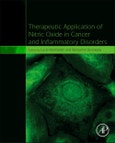Therapeutic Application of Nitric Oxide in Cancer and Inflammatory Disorders presents updated reviews on the chemistry, signaling, pre-clinical and clinical activities on the role of nitric oxide donors/inhibitors used alone and in combination with other therapeutic agents for the treatment of a variety of diseases. This book examines various studies related to the application of novel therapeutic NO (donors/inhibitors) compounds in the treatment of various cancers. These studies have been shown to exert significant therapeutic activities against various cancers and various inflammatory diseases such as rheumatoid arthritis, Crohn's disease, allergies, and asthma, where no current effective therapies exist. Pathologies based on functional and structural vascular alterations are also taken into consideration.
Edited and written by internationally renowned experts in the field of novel therapeutics for cancer, this book is a valuable source for cancer researchers, medical scientists, clinicians, clinical pharmacologists, and graduate students.
Please Note: This is an On Demand product, delivery may take up to 11 working days after payment has been received.
Table of Contents
I. Applications of Nitric Oxide in Cancer 1. Nitric Oxide-Releasing Engineered Nanoparticles: Tools for Overcoming Drug Resistance in Chemotherapy 2. Reversal of Multiple Cancer Oncogenic Pleiotropic Properties by NO-modulating Therapies 3. Antitumor Effect of a Metal Nonoate Through Angiogenesis Impairment 4. Therapeutic Implications of the Nitric Oxide Pathway in the Angiogenesis of Tumors and Inflammatory-Related Disorders 5. Nitric oxide and cancer: To inhibit or to induce iNOS That is the Question? 6. Arginine Metabolism Regulates Nitric Oxide Production in Melanoma Tumor Microenvironment to Provide Survival Advantage to Tumor Cells 7. Cancer and Beyond: Discovery and Development of NO-releasing Therapeutics 8. Nitric Oxide Scavenging-Based Therapies for Targeting Colorectal Cancer 9. Therapeutic Aspects of Protein Denitrosylation 10. Nitric Oxide-Releasing Functional Nanomaterials for Anticancer Therapy
II. Applications of Nitric Oxide in Inflammatory-Related Disorders 11. The Role of Nitric Oxide on Vascular Dysfunction During Aging and Alzheimer's Disease 12. Carbonic Anhydrase Inhibitor NO Donor Hybrids and Their Pharmacologic Applications 13. Understanding the Roles of Nitric Oxide During Sepsis, an Inflammatory Disorder 14. Nanoporous Materials: New Generation of Nitric Oxide Donors
III. Abstracts (Presentations at Conference in Siena, October 4th-5th, 2018) A. Serum Nitric Oxide Metabolites and The Incidence of Metabolic Syndrome and Its Phenotypes: A Population-Based Prospective Study B. Nitric Oxide (NO): A Multifaceted Target for Reversal of Cancer Cell Pleiotropic Properties by NO-modulating Therapies C. Pharmacology of Hepatoselective Nitric Oxide Donors in NAFLD in Mice D. New NO-Releasing Doxorubicins as Targeted Therapy Against Chemoresistance in Castration-resistant Prostate Cancer: In Vitro and In Vivo Evaluations E. Anticancer Effect of a Novel H2S-Hybrid Molecule on Human Breast Adenocarcinoma (MFC-7) and Human Breast Epithelial (MCF-10A) Cell Lines F. Heme Oxygenase-1 In Duchenne Muscular Dystrophy: Interaction with Nitric Oxide Synthase Pathway in Satellite Cells Differentiation G. In Vitro Assessment of NitDox Toxicity Towards Vasculature H. The Regulation of GSNOR Expression Discloses the Role of S-nitrosylation in Aging and Disease I. Effects of Long-term Nitrite Supplementation on Gene Expressions of GLUT2, GLUT4 and Glucokinase in Male Obese Type 2 Diabetic Rats J. Nitric Oxide Re-Instates Doxorubicin Cytotoxic and Pro-Immunogenic Effects in Refractory Breast Cancer K. Anti-Cancer Activities of Erucin a H2S-donor Isothiocyanate from Eruca Sativa Mill.: Is H2S the Real Player? L. Hydrogen Sulfide as a Signaling Molecule in The Cardiovascular System: Actions and Interactions with NO M. Nitric Oxide in Cancer Resistance to Cisplatin: Tumor Associated Macrophages as Key Players. N. Therapeutic Potential of Nitric Oxide Modulation in Ocular Diseases: A Focus on Novel NO-Releasing Molecules O. Pro-Apoptotic Effects of S-Nitrosothiols O-Chloro and M-Chloro S-Nitroso-Aryl-Amides in Human Breast Cancer Cell Lines P. Light Guided Production of Nitric Oxide and Singlet Oxygen for the Multi-Modal Treatment of Cancer Q. Potential for Chemoprevention with Nitric Oxide- and Hydrogen Sulfide-Releasing Drugs R. H2S Metabolism in Colon Cancer Cells Exposed to Hypoxia








